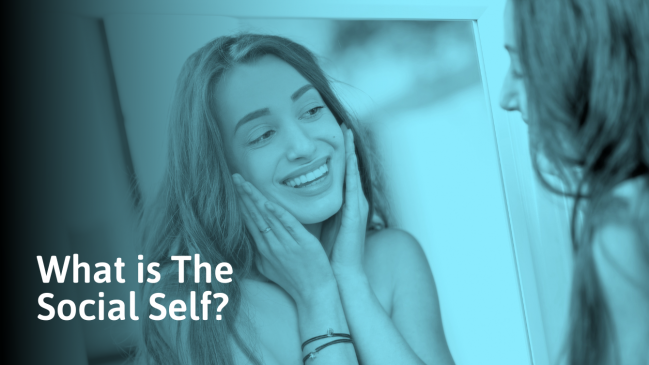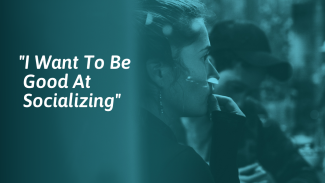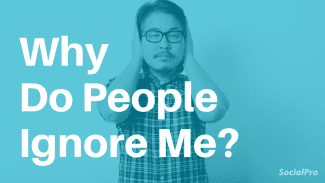If you’re interested in psychology, you might have come across references to the social self. But what exactly does the term mean? In this article, we’ll look at how psychologists have defined the social self, and how it influences social interactions.
Sections
What is the social self?
The social self is a broad term, and there are multiple definitions. Here is an overview of what the social self can mean:
The APA’s definitions of the social self
The American Psychological Association has three definitions of the social self. The first definition is:
“Those aspects of one’s identity or self-concept that are important to or influenced by interpersonal relationships and the reactions of other people.”[1]
For example, you may identify as a supporter of a particular sports team. This identity is part of your social self because it is important to your relationships and affects how you interact socially with other people. Maybe you like to make friends or hang out with people who support the same team, or dislike people who support a rival side, even if you don’t know them very well.
The second definition of the social self is simpler:
“A person’s characteristic behavior in social situations.”[1]
For example, your social self might be an outgoing, extroverted personality or a reserved introvert. But the social self is not completely consistent; you can change your behavior to suit different social situations.
This is our favored definition of the social self, because it is simple and intuitive.
The APA’s third definition of the social self is:
“The facade that an individual may exhibit when in contact with other people, as contrasted with his or her real self.”[1]
This definition acknowledges that your social self might not always be authentic. Most of us have had the experience of putting on a mask in a social situation or trying to fit in by hiding who we truly are or how we are feeling. For example, you may feel low or worried one day but hide your anxiety and pretend to be happy when you’re out with a group of friends.
Sapien Lab’s definition of the social self
A group of researchers from a nonprofit called Sapien Labs recently created a tool to measure overall mental health: the Mental Health Quotient (MHQ). The tool measures six categories of mental health, including “social self.”
According to the researchers, the social self is:
“The ability to interact with, relate to, and see oneself with respect to others. It includes factors like confidence, communication skills, self-worth, body image, empathy, and relationship building. Abnormal forms of social functioning include excessive unprovoked aggression, a strong sense of being detached from reality, or suicidal intentions.”[2]
This definition differs from the way psychologists (and the APA) normally describe the social self. Here, the social self is defined as a collection of behaviors, skills, and attitudes that can be measured using a scale. A high score suggests that a person has a strong social self, which is important for good mental health and satisfying relationships.
Examples of the social self in action
As mentioned above, our preferred definition of the social self is “A person’s characteristic behavior in social situations.”
In this chapter, we are going to draw on various psychological theories and models to show how the social self can change and develop.
The social self and group membership
Your social self is partly shaped by the groups you identify with. For example, if you are studying at Harvard, “Harvard student” may be an important part of your social self. Or, if you are a teacher, your profession may be a big part of your identity.
This kind of group identification can change your behavior in social situations. Specifically, it shapes the way you treat other people. For instance, we tend to prefer people who are members of our group. We like to feel good about ourselves. By favoring the groups we belong to, we can boost our self-esteem. If we think that members of our group are mistreated, we might feel angry on their behalf.[3]
The social self and comparisons
Your social self is partly based on labels and identities, such as “intelligent” or “funny.” But these labels aren’t meaningful if we don’t know how we compare to everyone else. To help us decide whether we really do have a certain trait or truly fit into a certain category, we can use social comparisons.
We tend to make two types of comparisons: upwards social comparisons and downwards social comparisons.
- Upward social comparisons involve comparing ourselves to people who appear to be better or more successful than us in some way, e.g., “She earns three times as much as I do. She’s way more ambitious than I am!”
- Downwards social comparisons involve comparing ourselves to people who appear to be worse off, e.g., “Compared with his kids, my children are much more obedient!! I’m probably a better parent.”
As a general rule, upward social comparisons make us feel worse about ourselves, and downward social comparisons help us to feel more positive about who we are.
But upward social comparisons don’t always have negative effects on your behavior and feelings; they can even be beneficial.[4] For example, if you feel envious of someone because they have a group of close friends, this could be the push you need to start developing your social skills.
The social self and self-presentation
Your social self can adapt, depending on who is around. You may show a particular set of behaviours or traits, such as confidence, when you’re around friends but not when you’re meeting your new boyfriend or girlfriend’s parents for the first time.
Most people adapt their behavior (whether consciously or unconsciously) to make a good impression on others. This is called self-presentation.[5]
For example, when you go for a job interview, you probably want to make the interviewer think that you are professional, intelligent, and conscientious. You might make a special effort to show up on time, introduce yourself by your first and second name, shake the interviewer’s hand, and speak in a formal way (e.g., without slang or profanity).
But if you are getting to know someone at a party, you might want to come across as friendly, fun, and warm. To create this impression, you might smile, laugh, make jokes, give compliments, and talk about light topics.
Adjusting your behavior in this way can be a useful skill. It’s a completely normal part of social interaction and doesn’t necessarily mean you are fake or manipulative.
Individual differences in self-presentation
Some people are comfortable changing their behaviors to suit a social situation. In other words, their social self is more flexible. In psychology, they are known as high self-monitors. Others, known as low self-monitors, are less likely to adjust their behavior to suit their audience.[6]
High self-monitors are willing and able to fit in with other people; they will put on a mask or act if they think it will earn approval. Low self-monitors are less likely to do this. Instead, they use their personal standards to decide how they will act.
For example, a high self-monitor might downplay their political beliefs if they want to impress someone who holds different views. A low self-monitor would be more likely to state their views and argue for their beliefs.
Self-expansion theory
When we get to know someone, either platonically or romantically, we have the opportunity to share their identities and experiences.[7] These new identities and experiences can change the ideas you hold about yourself. When your self-image changes, your social self may change as well.
For example, you might start dating someone who loves to ski, and you may develop your own passion for the sport. In time, you might start to think of yourself as “a keen skier.” In social situations, you may be keen to talk about skiing, introduce yourself as a skiing enthusiast, and find other people to ski with.
Or you may become close friends with someone who introduces you to a new set of political beliefs that changes your worldview. As you come around to the other person’s way of thinking, you might start to think of yourself as liberal rather than conservative or vice versa, which might be reflected in the things you say to others.
Close relationships with other people can also give you access to more knowledge, social status, possessions, wealth, or membership in a community. For example, if you make friends with someone who is well-respected in your local business community, they could help you make valuable professional connections.
The psychologists who proposed this theory don’t think that we have relationships because we want to take advantage of other people. When we get to know someone, we aren’t always aware of our own motivations.[7] We also tend to help people who help us; most friendships are based on a balance between giving and taking.
The labeling bias
Your social self is affected by labels—both the labels others give you and the labels you give yourself. These labels can have a direct effect on your behavior in social situations.
Most of us have been labeled at some point. Labels can be informal (e.g., “bad at math” or “emotional”) or formal (e.g., “someone diagnosed with depression”). These labels can influence what other people expect from us. In psychology, this effect is known as the labeling bias.
The labels other people give us can also become self-fulfilling prophecies.[8] We may start to meet other peoples’ expectations (with or without conscious awareness). For example, we might be less likely to speak up in social situations if other people have labeled us as “quiet” or “shy.”
Sometimes, we can internalize a label and make it part of our identity. This is called “self-labeling.” For example, one study found that teenagers who had been diagnosed with a mental illness and used the diagnosis as a label had lower self-esteem than those who didn’t.[9]
Self-discrepancy theory
The self-discrepancy theory proposes that we have not one but three selves: the actual self, the ideal self, and the ought self.[10]
- The actual self is your idea of who you are right now. (For example, you might think you are a hardworking employee, a reasonably good friend, and an average partner. This self includes the qualities you believe that other people see in you.)
- The ought self is the version of yourself that you think other people want or expect. (For example, you might think your parents want you to have a very high-paying job.)
- The ideal self is the version of yourself that you’d like to be. (For example, you might want to be much more extroverted, or you might wish you were smarter.)
These selves can influence your social self. For example, if your ideal self is outgoing and funny, you might make a special effort to live up to that ideal by telling more jokes or going out of your way to make conversation with potential friends. Or let’s say that your relatives place a high value on formal etiquette. You might take extra care to watch your manners when you visit them, because your ought self is extremely polite.
These three selves don’t always match up. For example, let’s say your ideal self works for a nonprofit and lives a modest lifestyle. However, if you believe that your parents want you to have a high-status corporate job and make lots of money, your ought self doesn’t share the same goals.
The psychologist behind self-discrepancy theory, Tory Higgins, believed that when these selves aren’t aligned, we may feel uncomfortable.[10]
For example, if there is a big gap between our actual or ideal self and our ought self, we can feel conflicted, guilty, or disloyal. In the example above, you might feel bad because the lifestyle you’d like to lead doesn’t match with what your parents want for you.
The looking-glass self
According to the looking-glass self theory, our self-image is partly based on how we think other people see us. For example, if many people say that you are a talented musician, you may start to see yourself in the same way.
When we base our self-image on what we believe other people think about us, we might change how we behave towards others and how we respond to social situations. In other words, our social self shifts. We may start looking for evidence that supports or disproves the ideas we have about ourselves. Depending on how others respond to us, we may adjust our self-image.
Here’s an example: Let’s say your friend introduces you to a couple of their other friends. You believe that you are capable of making a good first impression because several people have said things like “You always come across well when you meet new people” in the past.
As you make conversation, you’ll probably take note of how everyone is responding to you. If they appear friendly and happy to be in your company, your image of yourself as a person who can make a positive first impression will be confirmed. But if your new acquaintances look awkward, you may start to wonder, “Do I actually come across well when I talk to new people?”
The original looking-glass theory was proposed in 1902.[11] Since then, other researchers have tested the theory and expanded upon it.
For example, a 2003 study published in the journal Social Forces found that the relationship works both ways: although our sense of self is affected by other people’s behavior, our behavior also determines how they see us. Through consistent behavior, we can change our reputation. In time, someone else’s idea of who we are may begin to align with our own self-perception.[12]
Culture and the social self
Your social self is influenced by your culture. From birth, we receive powerful messages from the people around us about how we should define ourselves and how we should behave around others.
Psychologists often talk about “individualist” or “collectivist” cultures. As a general rule, in individualist cultures, people are encouraged to think of themselves as independent beings with a unique collection of traits. Independence and ambition are seen as positive qualities.
However, in more collectivist cultures, people learn to think of themselves in terms of their relationships with others. Modesty, gratitude, loyalty, interpersonal ties, and a communal spirit are highly valued.[13]
Our cultural background impacts the way we see ourselves. Someone who has grown up in an individualistic culture may be more likely to focus on their personality traits when describing themselves (e.g., “I’m hardworking, religious, confident, and friendly”), but someone from a collectivist culture might define themselves mostly in terms of their relationships (e.g., “I’m X’s son, Y’z husband, and I work for Z”).
In social situations, people from collectivist cultures are more likely to aim for group harmony compared to people from individualist cultures, who are more willing to express their personal wants and needs.
If you have grown up in an individualist society, you may be comfortable using an assertive, bold communication style and disagreeing openly with other people, even when you’re working together in a team. In other words, your social self may be outgoing, direct, and self-serving.
However, if you are more comfortable with collectivist norms, your social self may be more conformist and malleable. Compared to people from an individualist culture, people from collectivist cultures usually try to avoid direct confrontations and demands.[14] When putting forward an alternative view or criticism, they might take extra care to voice their opinion in a tactful way that makes it clear they don’t want to embarrass or undermine others.











Thank you so much I think I have gotten the best out of it,I also inquire for the educational implications of social self to education
Hi i want become interesting i feel boring i don’t know how to talk to people and engage conversation make more friends please tell how to overcome anxiety and nervous it feel so hard how to it that situation